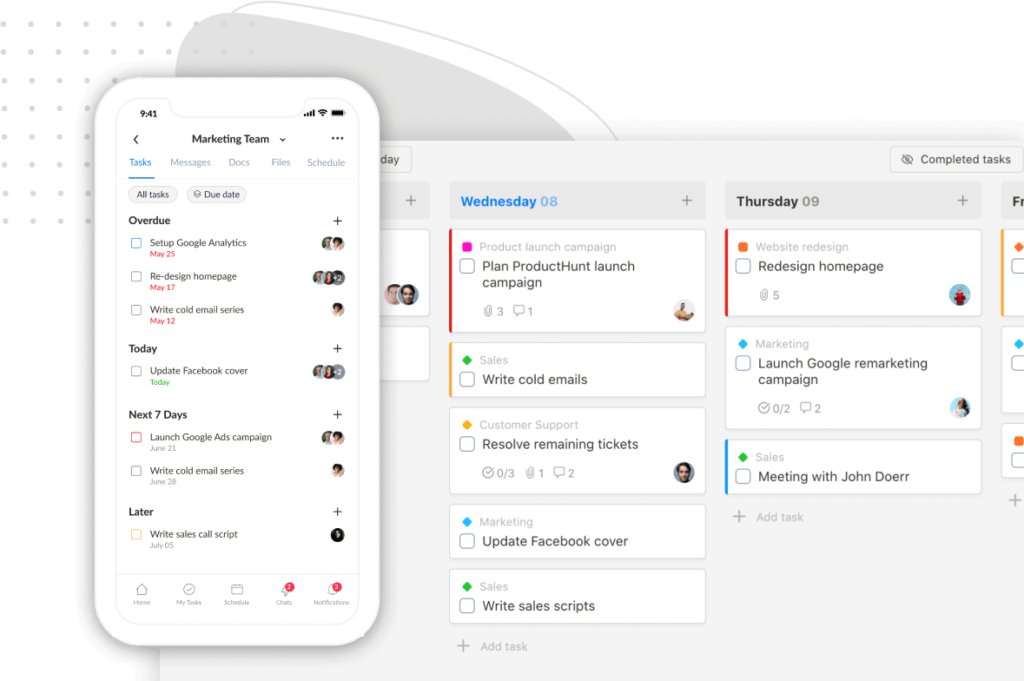Do you ever feel like you’re shouting into the void when communicating with your remote team? Been there, done that.
The physical distance can make it tough to stay on the same page, leading to missed deadlines and frustrated team members.
But fear not! Collaboration technology has emerged as a powerful bridge, allowing remote teams to overcome these communication hurdles and thrive.
In this post, we’ll explore the specific ways collaboration tools can address your pain points, fostering a more connected, engaged, and productive remote workforce.
I. The Struggle is Real: Common Communication Challenges In Remote and Hybrid Work
Let’s be honest, the shift to the remote and hybrid work environment has been amazing for flexibility and finding great talent. But it’s also thrown some communication curveballs our way.
Here’s a breakdown of some of the most common roadblocks you might encounter:
1. Real-time hurdles
Remember those quick hallway questions, brainstorming sessions that popped up, or just catching someone at the coffee machine?
Yeah, those are gone for remote work.
This can slow decisions down and leave them feeling out of the loop.
2. Information Overload
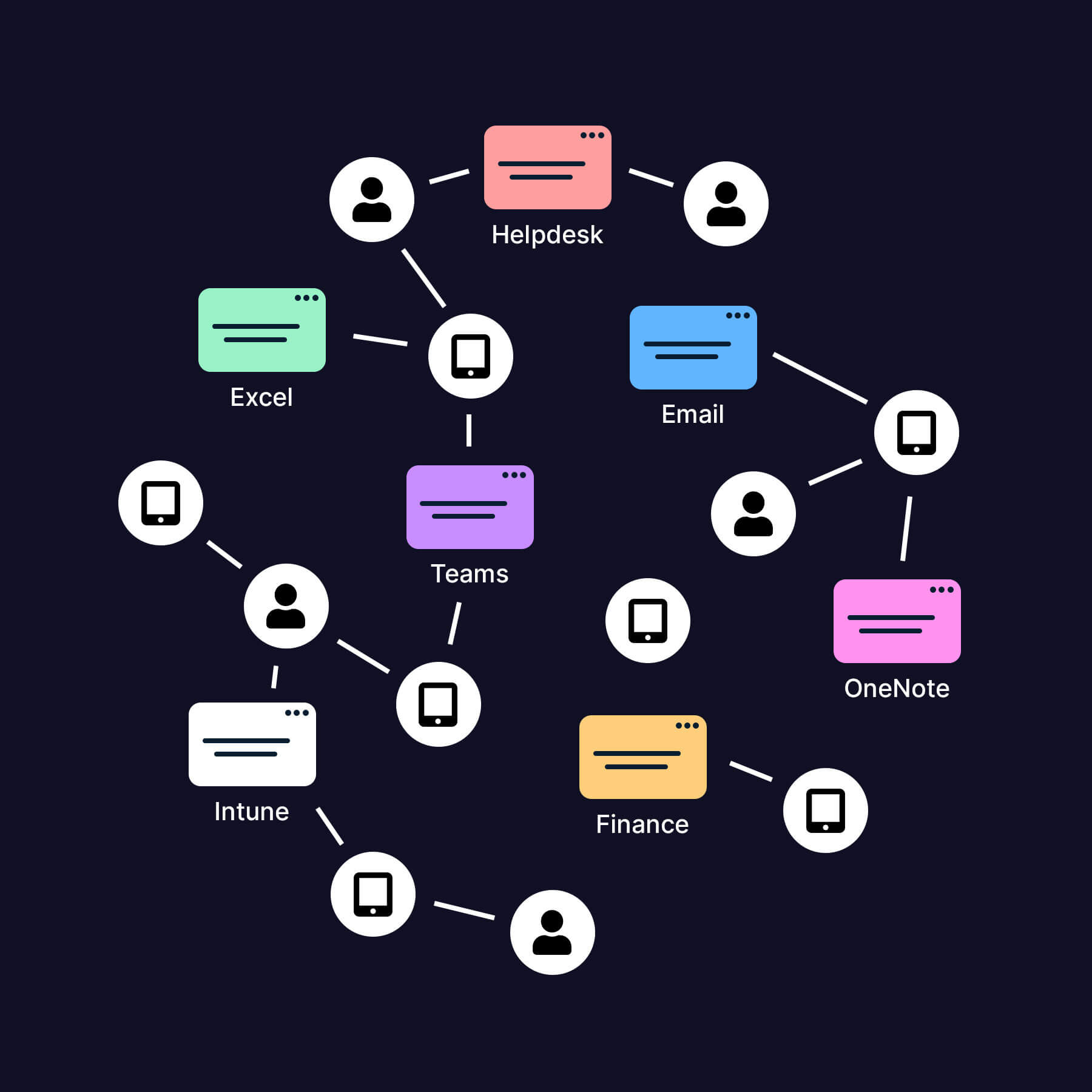
Ever feel like updates and project details are scattered everywhere – emails, chats, documents – like a never-ending game of hide-and-seek?
Without a central hub, things get lost, leading to confusion, wasted effort, and missed deadlines.
3. Engagement and isolation
Remote work can make it tough to feel connected to the team and company culture.
No more watercooler chats or those random interactions that build relationships.
This can lead to isolation, especially for new hires who haven’t had a chance to build relationships with colleagues face-to-face.
4. Building Trust Without Seeing You
Getting to know and trust people you don’t see in person can be a challenge.
Without those nonverbal cues and body language, it’s harder to gauge how people are feeling, if they’re on board, and how the team is gelling overall.
This can lead to misunderstandings, frustration, and a hesitation to open communication.
5. Drowning in Notifications

The constant pinging of emails, chats, and messages across different platforms can be overwhelming. It’s easy to lose focus, struggle to prioritize, and feel burnt out.
6. Inequities for hybrid teams
In hybrid teams, communication challenges can arise from a lack of consistency.
Remote team members might feel excluded from in-person conversations or miss out on important information shared during virtual meetings that they can’t attend virtually.
This inconsistency can create a sense of unfairness and hinder collaboration between in-office and remote employees.
These challenges show us why clear communication strategies and the right digital collaboration tools are essential for bridging the gap in remote and hybrid work.
In the next section, we will explore how collaborative technologies can act as a bridge, fostering a more connected, engaged, and productive remote or hybrid workforce.
II. How Does Collaboration Technology Support Your Business?
1. What Is Collaboration Technology?
Collaboration technology refers to a set of tools – apps, software, and sometimes even hardware – that helps virtual teams stay connected, share ideas, and work on things together in real-time.
Think of it as a digital office that keeps everyone connected and up-to-date, even when miles apart.
2. Benefits of Collaboration Technologies for Modern Workplace
Remember the challenges we discussed earlier – communication gaps, information silos, and difficulties building trust remotely?
Collaboration technologies directly address these pain points.
They make remote and hybrid work more streamlined and productive.
Let’s explore the benefits these tools bring to workplace collaboration:
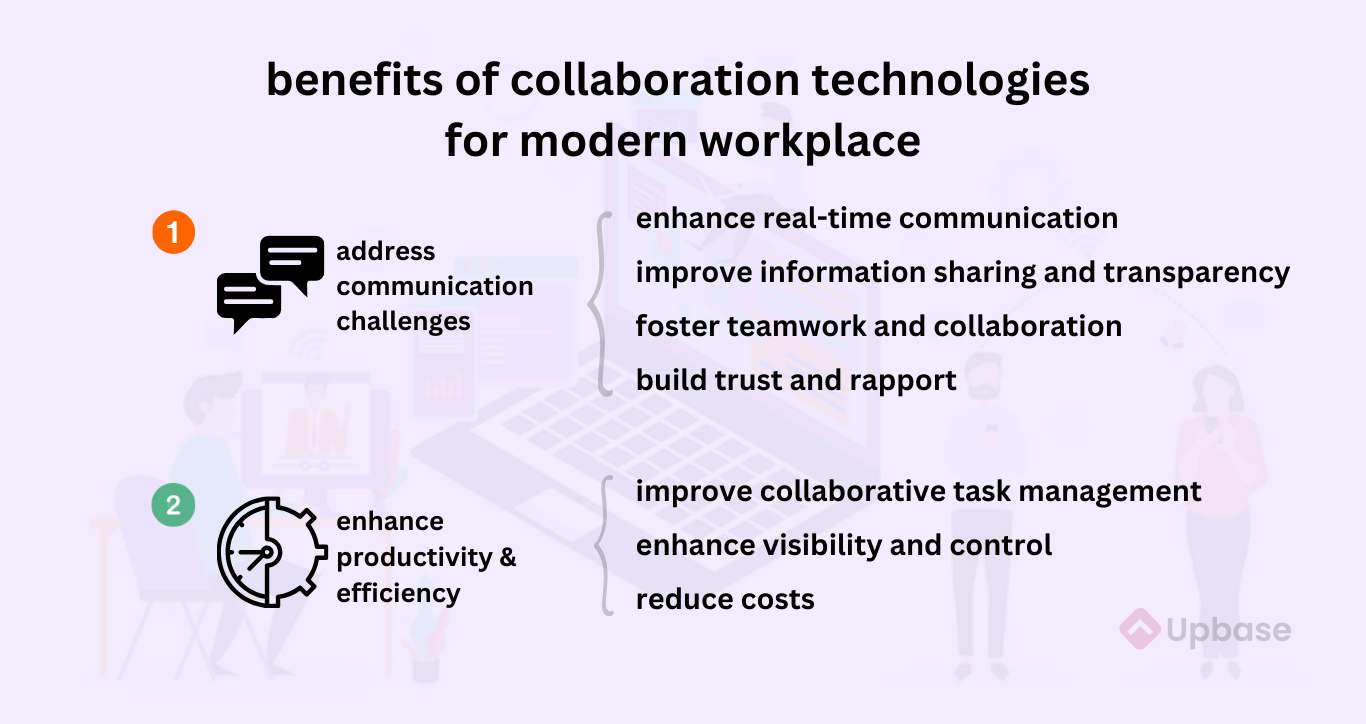
2.1. Collaboration Technologies Address Communication Challenges
Collaboration technology directly combats several communication hurdles highlighted earlier. Here’s how:
- Enhance Real-time Communication
Tools like video conferencing platforms enable spontaneous conversations, quick check-ins, and streamlined decision-making, regardless of location.
- Improve Information Sharing and Transparency
Cloud-based document editing and project management systems create a central hub for project updates, files, and discussions, ensuring everyone stays on the same page.
- Foster Teamwork and Collaboration
Features like collaborative whiteboards and virtual team-building activities encourage brainstorming, problem-solving, and team building in a remote setting.
- Build Trust and Rapport
By facilitating regular interaction, information sharing, and virtual team-building activities, collaboration technology helps build trust and rapport within remote and hybrid teams.
2.2. Collaboration Technologies Enhance Productivity and Efficiency
The benefits of collaboration technology extend beyond just communication:
- Improve Collaborative Task Management
Project management platforms streamline workflows, track progress, and ensure deadlines are met, leading to increased efficiency and project success rates.
- Enhance Visibility and Control
Managers gain greater visibility into team workloads and project schedules, allowing for better progress tracking and decision-making.
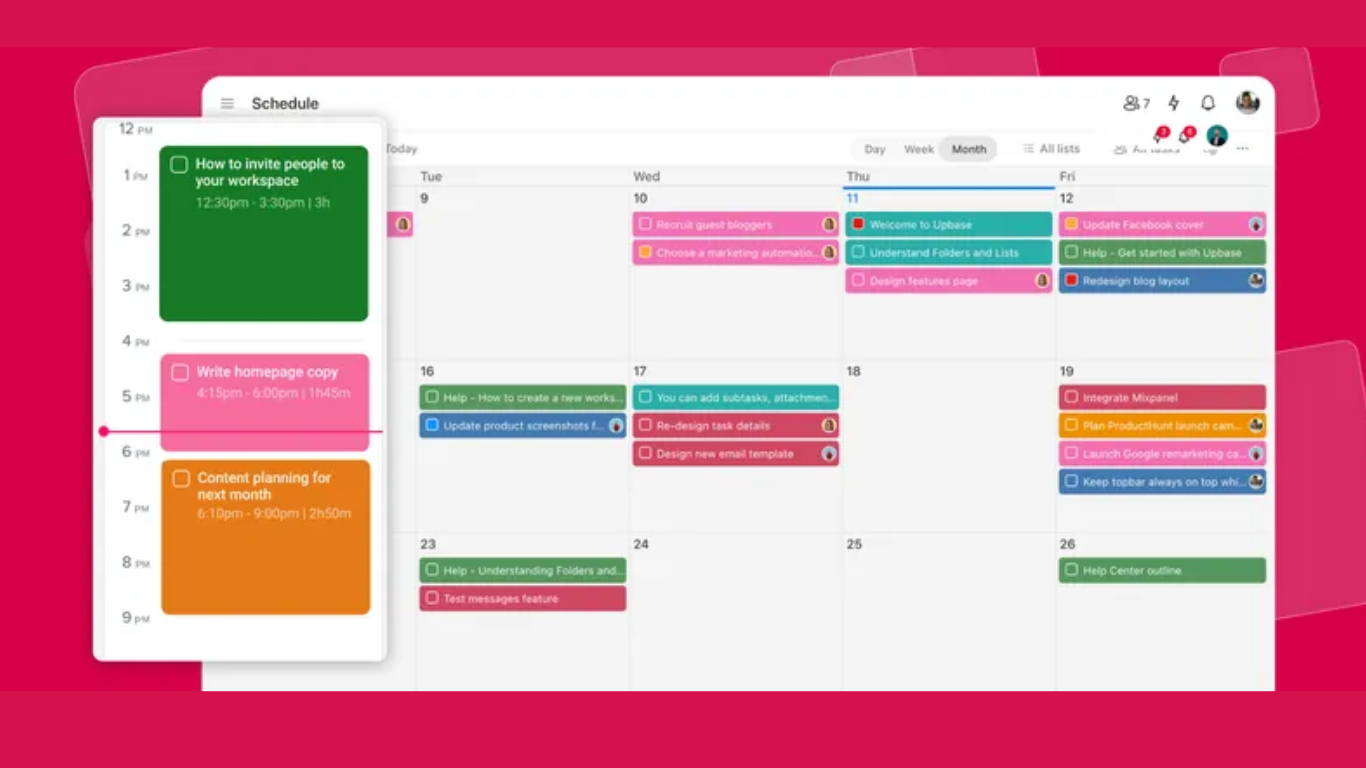
- Reduce Costs
Collaboration technology can eliminate the need for travel and physical office space, leading to cost savings for organizations with remote or hybrid workforces.
3. Case Studies: Collaboration Technology Bridging the Gap
The benefits of collaboration technology for remote teams are not merely theoretical.
Here are common examples of companies that successfully utilized these tools to bridge communication gaps and empower their remote workforces.
Example 1: Automattic Increases Efficiency and Transparency with Collaboration Platform
Challenge:
Automattic, the company behind WordPress.com, has a massive and geographically dispersed workforce.
Managing communication and team collaboration across different time zones and work styles proved challenging.
Solution: Automattic built an internal communication and project management platform for their teams.
This platform serves as a one-stop shop for all communication and team collaboration needs, including:
- Streamlined Project Management: The platform helps teams create projects, assign tasks, track progress, and share files. This centralized platform ensures everyone has access to the latest information and deadlines are met efficiently.
- Real-time Collaboration: Built-in chat features facilitate instant communication between team members, regardless of location. This allows for quick questions, clarifications, and faster decision-making on projects.
- Global Transparency and Visibility: The platform provides complete transparency into project progress for all employees, fostering a sense of accountability and ownership within the remote workforce.
Results: Since implementing this platform, Automattic has reported significant improvements in team efficiency, transparency, and overall collaboration.
The centralized platform has streamlined workflows, reduced communication silos, and empowered their remote workforce to achieve greater productivity.
Source: The book “The Year Without Pants: WordPress.com and the Future of Work” by Scott Berkun about remote working at Automattic.
Example 2: AGCO Corp. Cultivates Global Collaboration with Unified Communication
Challenge:
AGCO Corp., a multinational manufacturer of agricultural machinery, has a global workforce spread across diverse time zones and locations.
Traditional communication methods proved inadequate for seamless collaboration across borders.
Solution: AGCO Corp. implemented Cisco Jabber, a unified communication platform, to streamline communication and collaboration across their remote teams.
Here’s how it bridged the gap:
- Unified Communication Channels like instant messaging, voice calls, and video conferencing into a single platform. This allows team members to choose the most appropriate communication method based on the situation and urgency.
- Real-time Collaboration: Instant messaging features facilitate quick questions, clarifications, and real-time discussions. This fosters faster decision-making and problem-solving across continents.
- Improved Global Connectivity: Video conferencing capabilities enable face-to-face interaction, regardless of location. This creates a sense of connection and cultural understanding within the global workforce.
Results: AGCO Corp. reports a cost reduction of $45K per month since implementing the collaboration technology.
Along with that, their communication efficiency and productivity are significantly improved.
4. Major Collaborative Technologies for Effective Remote Work
Now that you understand the huge benefits collaboration technology offers for remote and hybrid teams.
Let’s explore the specific types of tools that can significantly improve communication within your organization.
4.1. Real-time Communication Tools:
- Video Conferencing Tools

These collaborative tools facilitate face-to-face interaction, replicating the natural flow of communication in in-person meetings.
Popular options include Google Meet, Zoom, and Microsoft Teams.
Video conferencing software allows for real-time collaboration, presentations, and brainstorming sessions, regardless of different locations.
- Instant Messaging Apps

These platforms provide a central hub for quick questions, real-time discussions, file sharing, and spontaneous team interactions.
Online collaboration tools like Slack or Microsoft Teams promote a more dynamic communication flow and keep everyone connected throughout the workday.
4.2. Cloud-based File and Document Collaboration Tools:
- Cloud-based Software for Document Collaboration

Collaboration platforms like Google Docs or Microsoft Office 365 allow for real-time collaboration on documents and spreadsheets.
This ensures everyone has access to the latest information, eliminates version control issues, and streamlines project updates.
Team members can work on the same document simultaneously, see edits as they happen, and collaborate seamlessly.
- File Storage and Collaboration Tools
Cloud storage platforms like Dropbox or Google Drive offer a central repository for storing and sharing all types of files.
These collaborative tools often integrate with other ones, allowing for easy access and version control within project workflows.
4.3. Project Management and Collaboration Software:
They are comprehensive project management systems that combine features from many different tools to streamline project workflows and communication within teams.
Here’s what these tools offer:
- Task Management: Task assignments, progress tracking, monitoring deadlines, and visualizing project workflows.
- File Sharing: Store and share project-related documents and files within the platform.
- Communication Modules: Built-in chat features, task comments, and discussion boards facilitate business communication around specific projects.
- Progress Tracking: Gain real-time insights into project progress and identify potential roadblocks.
4.4. Teamwork and Engagement Tools:
- Interactive Whiteboards and Mind Mapping Tools

Platforms like Miro or Mural provide a virtual workspace for brainstorming sessions, visual thinking exercises, and real-time collaboration on ideas.
This fosters a more engaging and interactive way to share ideas and build consensus remotely.
- Platforms for Virtual Team-Building Activities

Tools like Donut or Remo typically offer online icebreakers, team-building games, and social interactions, allowing team members to connect on a personal level and build trust.
They create a more positive and collaborative work environment, fostering better communication and team dynamics.
Choosing the Right Collaborative Software for Your Needs:
With a wide variety of collaborative software available, selecting the ones that best suit your team’s needs is crucial. Consider these factors:
- Team Size and Structure: Smaller teams might thrive with a few core tools, while larger teams may require a more comprehensive suite.
- Communication Preferences: Consider whether your team leans towards video communication, instant messaging, or project management software for daily interactions.
- Budget: Collaborative technologies come with a variety of pricing structures. Determine a budget that aligns with your needs and explore free trials before committing.
- Desired Functionalities: Make a list of the features most important to your team, such as real-time collaboration, file sharing, or project management functionalities.
By strategically implementing a combination of these types of collaborative technologies, you can empower your remote team to overcome communication challenges, foster a more connected work environment, and achieve greater success.
Introduce Upbase: Your All-in-One Solution for Streamlined Remote Team Communication
Imagine the frustration of juggling multiple apps for project management, communication, and document collaboration.
Scattered information, duplicated efforts, and a constant feeling of disorganization – these are all too common challenges for virtual teams relying on disjointed tools.
Upbase offers a refreshing alternative.
It’s a comprehensive, all-in-one project management software designed to streamline your team’s communication and collaboration efforts. Think of it as a central hub where your remote team can:
- Manage projects: Assign tasks, track progress, and visualize workflows – all within a user-friendly interface.
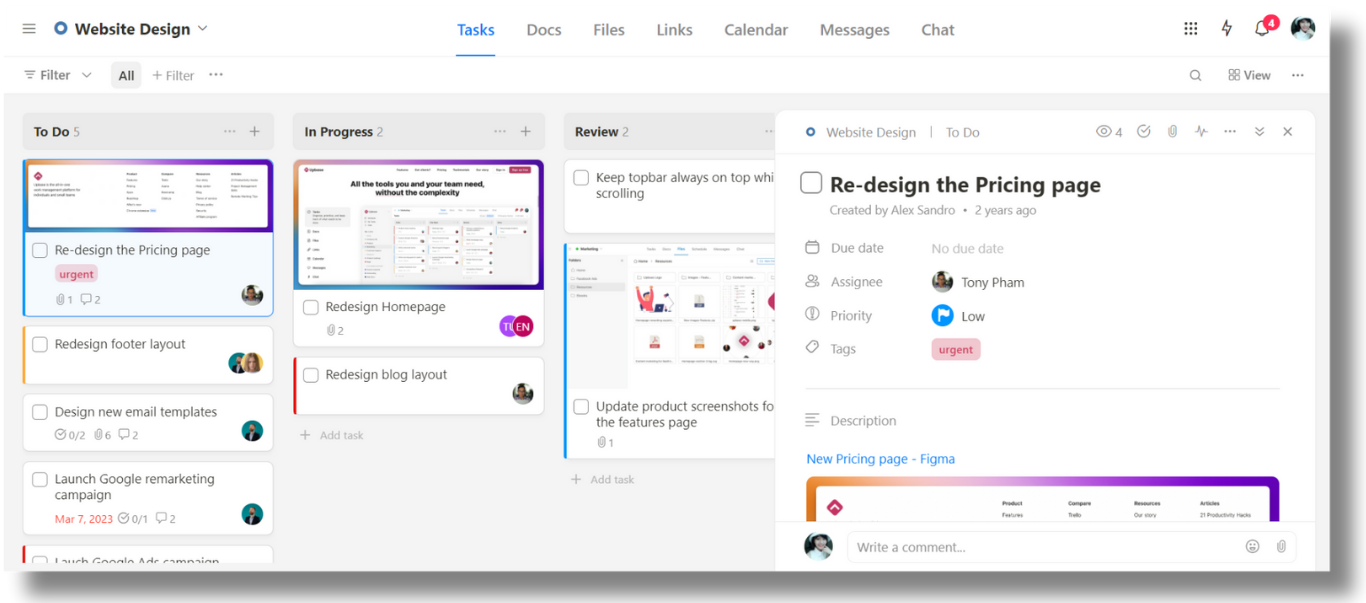
- Collaborate seamlessly: Work seamlessly together on documents, files, and links, ensuring everyone stays on the same page.
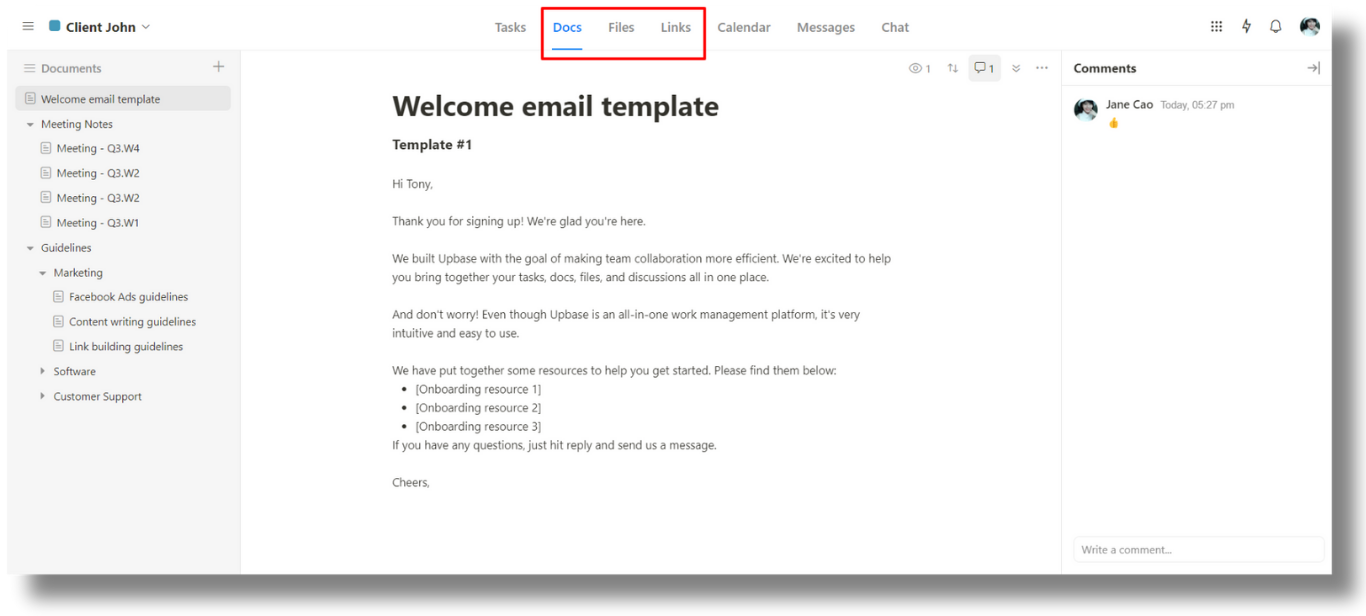
- Stay connected: Utilize built-in messaging and chat features to foster continuous communication and team engagement.
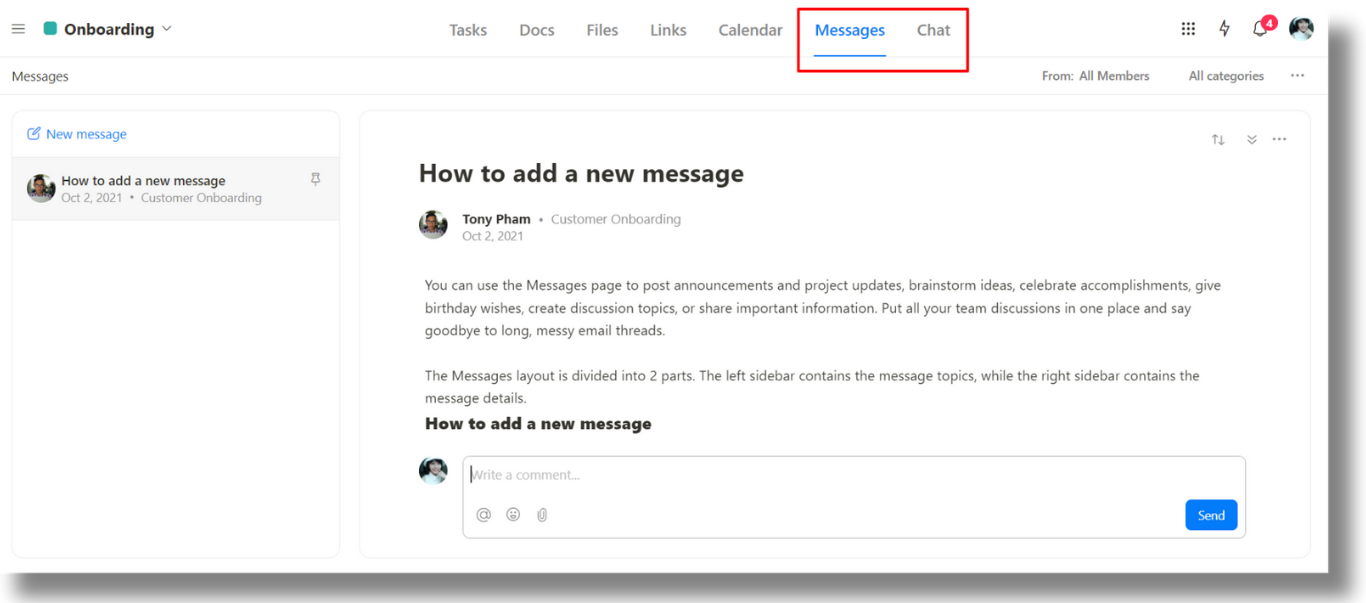
Eliminate App Overload, Achieve Greater Efficiency
Upbase eliminates the need to constantly switch between different tools. This reduces confusion and streamlines the collaborative experience.
Here’s a glimpse into Upbase’s functionalities that empower effective communication:
Organized Project Management: Upbase’s Tasks module allows for setting priorities, reminders, and deadlines. Features like assignees, task notes, comments, and attachments enhance collaboration.
If you’re juggling multiple projects simultaneously, list icons/colors, and folders can enhance navigation.
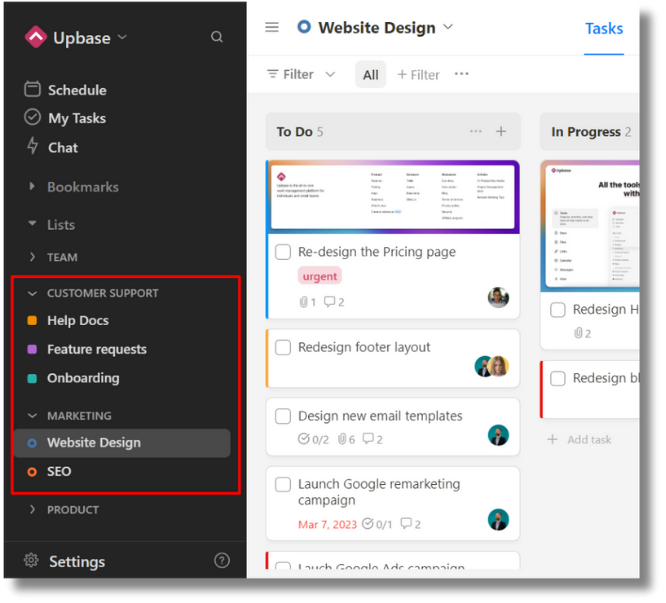
Flexible Task Views: Upbase caters to different work styles with List, Board, and Calendar views for tasks.
You can further customize your view with filters, and utilize drag-and-drop functionality and keyboard shortcuts for enhanced efficiency.
Real-Time Collaboration Made Easy
Upbase goes beyond just project management. It facilitates seamless collaboration through features like:
- Docs Module: Create, share, and work on documents simultaneously with your team. Upbase even integrates with Google Docs for a unified experience.
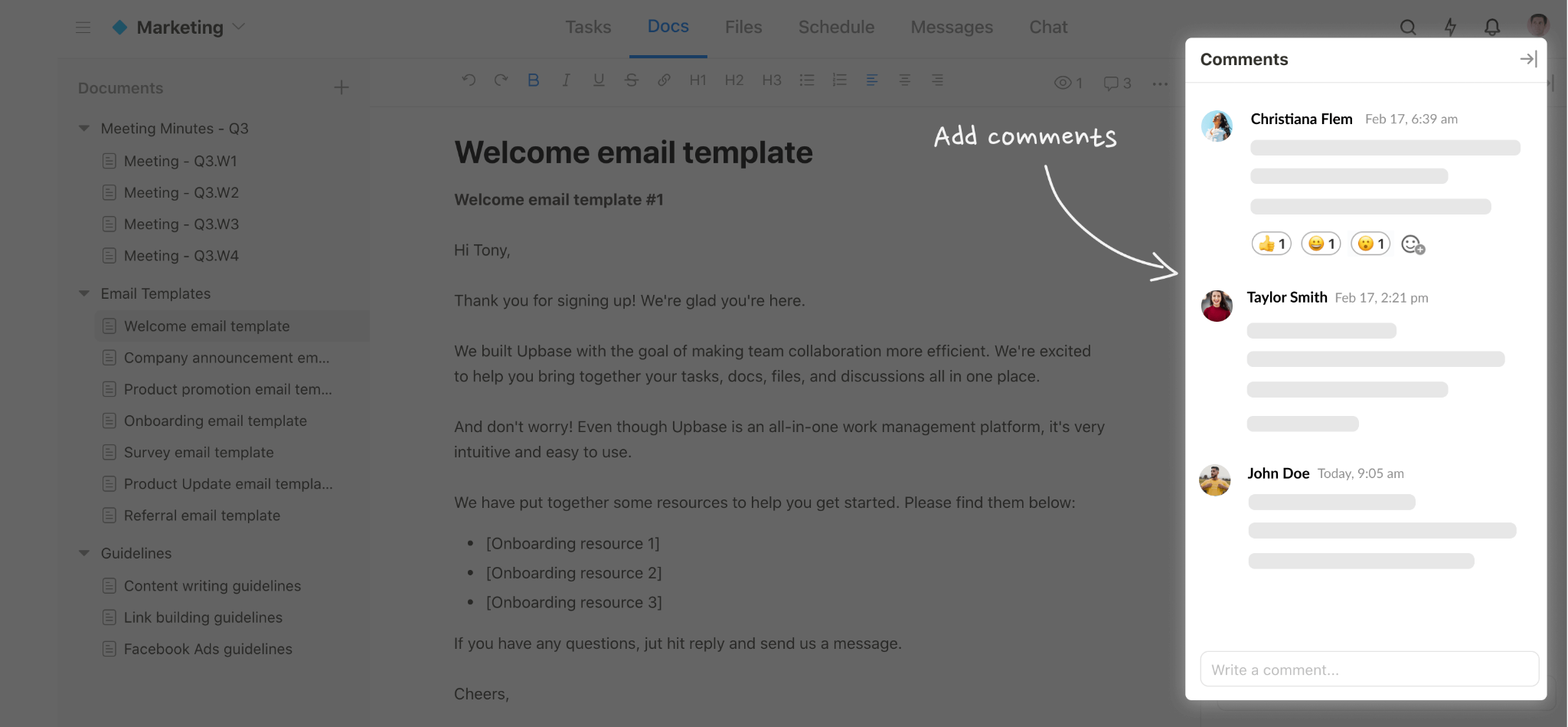
- Files Module: Store, manage file versions, and collaborate on files – features like watchers, comments, and link sharing ensure everyone is kept in the loop.
- Links Module: Keep important project links organized and easily accessible by your entire team.
- Messages and Chat: The built-in chat and messaging functionalities keep your remote team connected and foster real-time communication around projects.
Focus on Work, Not on Learning a New Tool
Upbase understands that powerful tools shouldn’t be complicated. That’s why it prioritizes ease of use.
The platform boasts a clean and intuitive interface designed for effortless navigation, even for less tech-savvy members.
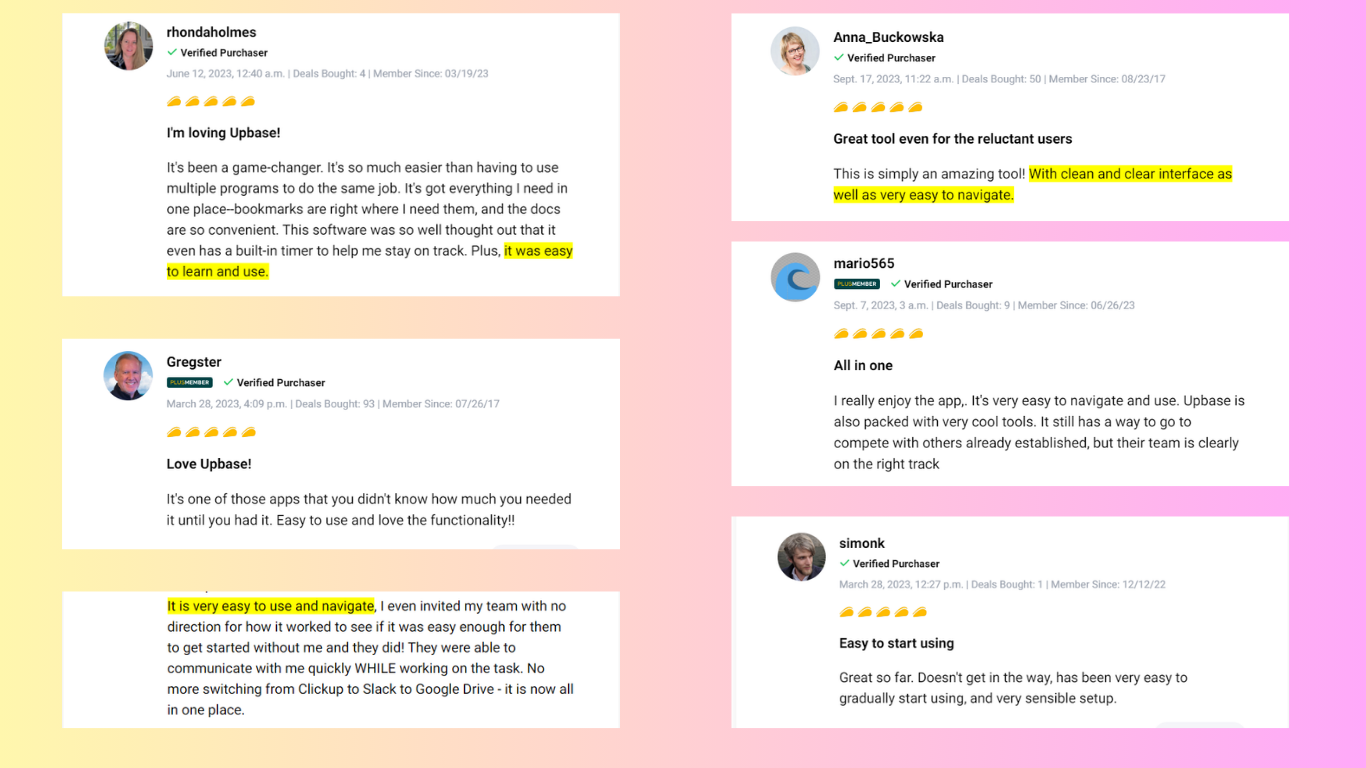
The best part?
Upbase offers a free-forever plan, allowing you to experience the power of collaborative teamwork firsthand.
Ditch the app overload and fragmented workflows. Sign up for Upbase today and unlock the potential of a truly connected and productive remote team!
III. Best Practices for Effective Communication in Digital Workspace
Equipping your remote team with the right collaboration technology is a crucial first step.
However, to truly bridge the communication gap and unlock the full potential of your distributed workforce, consider these best practices:
1. Establish Clear Communication Guidelines:
Decide which app works best for what. Urgent messages? Instant messaging might be the way to go. Project updates? A project management platform can keep everyone on the same page.
Set communication frequency: Schedule regular team meetings – daily huddles or weekly check-ins – to keep everyone connected. Don’t forget to carve out time for one-on-one chats with your team members too!
Document communication: Create a document (think online wiki) that outlines how things should work communication-wise. This includes things like how long it usually takes to get a response and how to use different chat channels politely.
2. Foster a Culture of Open Communication and Transparency:
Encourage regular information sharing: Promote clear communication by sharing company news, project updates, knowledge, and anything else relevant to your team freely.

Embrace transparency in decision-making: Transparency builds trust! When possible, involve your team in discussions and explain the “why” behind big choices. It makes everyone feel valued and in the loop.
Make leadership approachable: As a leader, make yourself available on designated channels. An approachable leader = a happy and communicative team.
3. Leverage Collaboration Technology for Effective Collaboration:
Use video conferencing: Schedule video meetings regularly. Seeing each other helps build connections and keeps nonverbal cues flowing, especially for brainstorming or team introductions.
Invest in the right collaborative software: Choose tools that match your team’s needs. Project management platforms with built-in chat features can streamline things nicely.
Encourage the use of asynchronous technology: Asynchronous communication tools like message boards allow for flexible communication. Team members can respond on their own schedule, conquering those pesky time zone challenges.
4. Prioritize Team Building and Social Interaction:
Schedule virtual team-building activities: Organize online games, social events, or casual coffee chats. It’s a great way to build camaraderie and friendships (even without the office watercooler).
Encourage casual connections: Create channels for informal chats and virtual watercooler moments. It helps maintain team spirit and that sense of belonging.
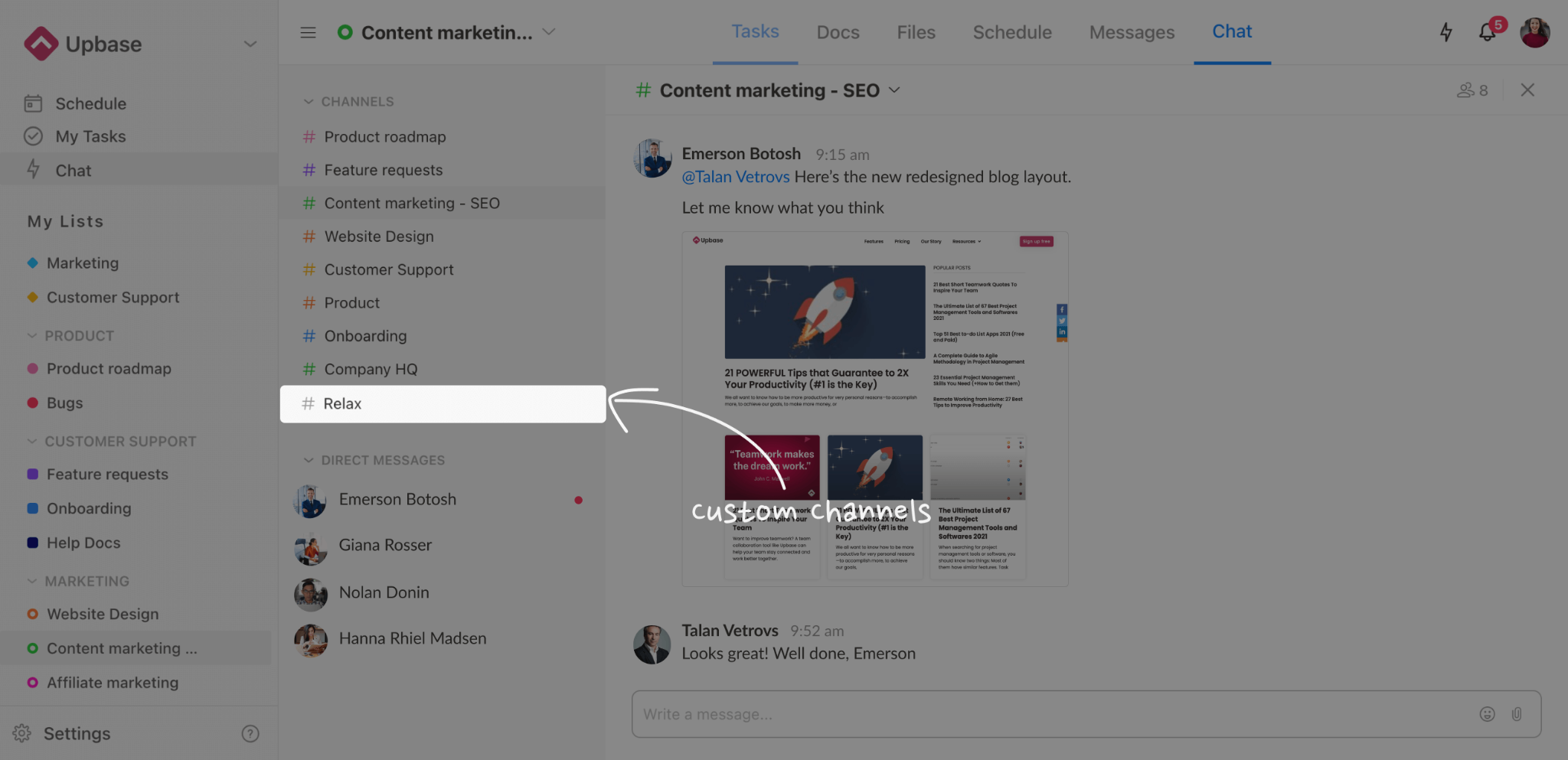
In Upbase’s Chat, users can create custom channels for informal group chats, maintain team spirit.
Recognize and appreciate team members: Publicly recognize individual and team wins. A little praise goes a long way in a remote work environment!
By following these tips and using digital collaboration tools effectively, you can create a thriving remote team environment with clear and consistent communication.
Remember, clear communication and a collaborative spirit are the keys to unlocking your remote team’s full potential and achieving amazing things together!
Conclusion: Building a Thriving Remote Team
The shift towards remote work presents both challenges and opportunities.
Remember, clear communication and a collaborative spirit are the keys to unlocking your remote team’s full potential and achieving amazing things together!
On top of that, embrace the power of collaboration technology to bridge communication gaps and enhance efficiency.
Give Upbase a try if you’re seeking a robust project management and collaboration platform that addresses your many communication needs in a single space. Sign up now!
FAQs
1. What are the 4 types of collaboration?
There are four main categories for collaboration styles:
- Team collaboration: This focuses on effective teamwork within an organization to achieve a common goal.
- Video collaboration: This emphasizes using video conferencing tools for communication and connection.
- Network collaboration: This involves collaboration within a network of people or organizations.
- Cloud collaboration: This focuses on using cloud-based tools to enable real-time document sharing and co-editing.
2. What are the advantages of collaborative technology?
Collaborative technology is like a super-powered teamwork tool.
It helps people work together on projects even if they’re in different places, which saves time and gets things done faster.
Communication is smoother, everyone can see the latest updates, and it can even boost team spirit!
3. How can technology be used as a tool for collaboration?
Tools like video chat and shared documents let people connect and work on projects together, no matter where they are.
This makes brainstorming easier, keeps everyone on the same page, and helps teams get things done faster.
4. What is the collaboration technique?
A collaboration technique is basically a way for a team to work together more smoothly.
It can be anything from how you communicate (like using a shared document) to fun team-building exercises.
The goal is to make working together easier and more productive!
5. What are common examples of tools that support collaboration?
Some common examples of tools that support collaboration are:
- Slack – for quick communication and updates.
- Upbase – for project management and collaboration.
- Zoom – for virtual meetings and face-to-face interaction.
